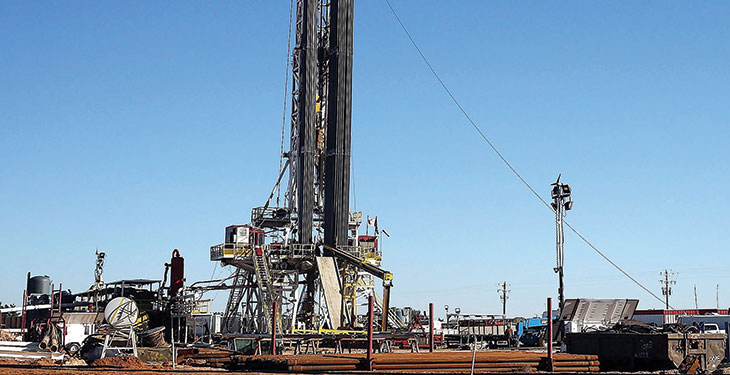Romania has a quite large inventory of unconventional continuous plays in the Paleozoic, Mesozoic, and Cenozoic periods mainly in the foreland and back-arc basins, says the abstract of the 43 pages article by Bogdan M. Popescu and Nicolae Anastasiu included in the book Shale Gas: Ecology, Politics, Economy, edited by Sergey S. Zhiltsov, in The Handbook of Environmental Chemistry collection of Springer.
A Romanian contribution to be published this end-year by Springer Publishing comes with an updated overview of unconventional resources of our country. Bogdan M. Popescu (Zeta Petroleum) and Nicolae Anastasiu (Romanian Academy) evaluate the possible technically recoverable resources at 1,000 billion cubic meters of gas and 500 million barrells of oil. “They show a tangible potential for investors once a specific legal framework is in place”, say the authors, who plead for a systematic geologic research of the Romanian unconventional resource basins to be included in the country’s energy strategy. This should involve “both the financing of NAMR’s non-exclusive studies and scientific research programs which will eventually allow the leasing of concessions to companies with high investing potential”. This is a short presentation of the main ideas of the research conducted by the authors.
The inventory presented in the article included unconventionals whose study is only in progress world-wide like the folded and fractured shales, clathrates, or shallow coal measures. The assessed units evaluated so far, following the EIA and USGS methodology is underway but first evaluations indicate technically recoverable resources of 1,000 bcm of gas and 500 million bbl of oil. They show a tangible potential for investors once a specific legal framework is in place.
The geological challenges for evaluating this category of resources are rather important because of the lack of novel information resulting from modern exploration and the classification regime of older one. The political hurdles are related to incomplete regulations, absence of community co-involvement, and the lack of any policy promoting the development of unconventional resources. The environmental debate has been very present in Romania and shall hopefully be solved with an unceasing consultation with the public society once new, transparent rules are set up.
The experts explain that the full assessment of the resources can be made only after projecting some exploration drillings which shall establish, preferably after a 3D seismic acquisition over the assessment units, the preliminary architecture, and sedimentary facies of the rock bodies. They also ask for a systematic geologic research of the Romanian unconventional resource basins must be included in the country’s energy strategy involving both the financing of NAMR’s non-exclusive studies and scientific research programs. This will eventually allow the leasing of concessions to companies with high investing potential.
Specific regulations must be issued as soon as possible by the government bodies.
In Romania, the practice of hydraulic fracturing in conventional fields is more than 60 years old, period during which there were successfully completed hundreds of such operations. However, in the twenty-first century, the exploration of unconventionals, followed by fracturing generated large anxiety and a prompt surge in public protests; they must be addressed by politicians and industry.
Citizen concern must be mitigated by the transparent regulations, the monitoring of the pre- and post-fracturing operations and by the public disclosure of chemicals used in the fracking fluids. In addition, communities must be co-interested in oil and gas activities of the country by allocating portions of petroleum taxes to them.
For now, the very low international price of the oil barrel and BTU of gas in 2015–2016 cooled down the exploration enthusiasm for most of the unconventional plays in Europe that would require at least USD 60/bbl for larger scale, new economic production projects. The downturn in prices that leads to a stagnation of worldwide industry activities has not bypassed the allegedly rich unconventionals of the Eastern and Central Europe. Romania’s nascent interest for these resources was stopped brutally hoping for a resumption of the research in better oil and gas price days.
However, challenges for setting up of a strategy for unconventional resource development are threefold. The geological challenges are related to paucity of modern data and therefore, the incipient knowledge and understanding of these plays. The political challenges for potential unconventional resource investors in the local situation are quite dense. Due to a quasi-total absence of governance in this domain, there has been an actual lack of commitment to regulate better the unconventional activity and risks. The environmental challenges already passed through very strong public and administration debates, evaluations, and analysis tough with no returns in the specific regulatory legislation.
To end with, it appears that if all above mentioned obstacles are addressed, Romania can reasonably start exploring for testing the unconventional resource potential. Once the production of unconventional oil or gas is established it has minimal visual and ecological impact. It would boost state budget with substantial tax income, reduce unemployment, and add to communities social benefits not mentioning the positive inroads into the future energy independence of the country.
—————————————-
The full version of this article can be read in printed edition of energynomics.ro Magazine, issued in December 2016.
In order to receive the next issue (March 2017) of energynomics.ro Magazine, we encourage you to write us at office [at] energynomics.ro to include you in our distribution list.
